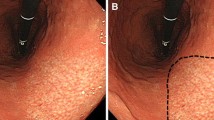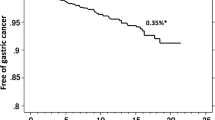Abstract
A retrospective long-term endoscopic followup study was designed to examine atrophic changes in the gastric mucosa over time inHelicobacter pylori-positive patients. Over a period of 8–17 years (mean, 13.4 years) 22 subjects (5 men, 17 women, mean age, 55 years) without localized gastroduodenal lesions underwent serial endoscopic examinations and serological and microbiological assessments ofH. pylori infection. The extent of atrophic mucosa in the gastric body was expressed using the Kimura-Takemoto classification of atrophic pattern. Atrophic patterns were unchanged over time in 7H. pylori-seronegative and culture-negative subjects with normal stomach, and in 1 seropositive and culture-negative subject with severe atrophy. Seven of 10H. pylori culture-positive subjects not including three with the O-3 pattern, i.e., open type atrophic pattern, exhibited a cephalad shift of atrophic pattern. The cumulative progression rates of atrophy in the culture-positive subjects excluding O-3 subjects, were 10% after 2 years, 20% after 4 years, 50% after 6 years, and 70% after 8 years. The increases in the extent of the atrophic area were discontinuous, in terms of age, in theH. pylori-positive individuals and occasionally advanced rapidly within periods of several years with no relation to age.
Similar content being viewed by others
References
Sipponen P, Kimura K. Intestinal metaplasia, atrophic gastritis and stomach cancer: trends over time. Eur J Gastroenterol Hepatol 1994;6(Suppl 1):S79-S83.
Fujioka T, Shuto R, Kodama R, et al. Experimental model for chronic gastritis withHellcobacter pylori long-term follow-up study inH. Pylori-infected Japanese macaques. Eur j Gastroenterol Hepatol 1993;5(Suppl 1):S73-S77.
Fujioka T, Kubota T, Shuto R, et al. Establishment of animal model for chronic gastritis withHelicobacter pylori: Potential model for long-term observations. Eur J Gastroenterol Hepatol 1994;6(Suppl 1):S73-S78.
Kohli Y, Kato T, Iwaki M, et al. Endoscopic diagnosis ofHelicobacter pylori distribution in gastric mucosa of patients with chronic gastritis. Eur J Gastroenterol Hepatol 1993;5(Suppl 1):S127-S131.
Sakaki N, Momma K, Egawa N, et al. The influence ofHelicobacter pylori infection on the progression of gastric mucosal atrophy and occurrence of gastric cancer. Eur J Gastroenterol Hepatol 1995;7(Suppl 1):S59-S62.
Kimura K, Takemoto T. An endoscopic recognition of the atrophic border and its significance in chronic gastritis. Endoscopy 1969;l:87–97.
Personnet J, Friedman GD, Vandersteen DP, et al.Helicobacter pylori infection and the risk of gastric carcinoma. N Engl J Med 1991;325:1127–1131.
Nomura A, Stemmermann, Chou P, et al.Helicobacter pylori infection and gastric carcinoma among Japanese Americans in Hawaii. N Engl J Med 1991;325:1132–1136.
Asaka M, Kimura T, Katou M, et al. Possible role ofHelicobacter pylori infection in early gastric cancer development. Cancer 1994;73:2691–2594.
Fukuda H, Saito D, Hayashi S, et al.Helicobacter pylori infection, serum pepsinogen level and gastric cancer: A case control study in Japan. Jpn J Cancer Res 1995;86:61–71.
International Agency for Research on Cancer. Infection withHelicobacter pylori. IARC monographs on the evaluation of carcinogenic risks to humans. 1994;177–220.
Veidhuyzen van Zanten SJO, Shermann PM.Helicobacter pylori infection as a cause of gastritis, duodenal ulcer, gastric cancer and non-ulcer dyspepsia: A systematic overview. Can Med Assoc J 1994:150:177–185.
Sakaki N, Momma K, Yamada Y, et al.Helicobacter pylori and gastric cancer: relation to arophic gastritis assessed by endoscopy. Eur J Gastroenterol Hepatol 1993;5(Suppl 1):S123-S126.
Gilvarry JM, Leen E, Sweeney E, et al. The long-term effect ofHelicobacter pylori on gastric mucosa. Eur J Gastroenterol Hepatol 1994;6:43–45.
Author information
Authors and Affiliations
Rights and permissions
About this article
Cite this article
Sakaki, N., Arakawa, T., Katou, H. et al. Relationship between progression of gastric mucosal atrophy andHelicobacter pylori infection: Retrospective long-term endoscopic follow-up study. J Gastroenterol 32, 19–23 (1997). https://doi.org/10.1007/BF01213291
Received:
Accepted:
Issue Date:
DOI: https://doi.org/10.1007/BF01213291




